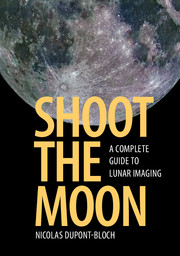Book contents
- Frontmatter
- Dedication
- Contents
- Preface
- 1 Introducing lunar imaging
- 2 Choosing your imaging equipment
- 3 Adapting your imaging device to the instrument
- 4 Tuning your telescope for lunar imaging
- 5 Wide-field lunar imaging
- 6 High-resolution lunar imaging
- 7 Essential image processing
- 8 Advanced image processing
- 9 Making 3D lunar images
- 10 Measuring and identifying lunar features
- 11 Photogenic features of the Moon
- 12 Naming, archiving, printing, and sharing lunar images
- Appendix 1 Maps of the Moon, the Lunar 100, and other targets
- Appendix 2 Webpages, books, and freeware for the Moon
- Appendix 3 Figure data
- Index
10 - Measuring and identifying lunar features
Published online by Cambridge University Press: 05 September 2016
- Frontmatter
- Dedication
- Contents
- Preface
- 1 Introducing lunar imaging
- 2 Choosing your imaging equipment
- 3 Adapting your imaging device to the instrument
- 4 Tuning your telescope for lunar imaging
- 5 Wide-field lunar imaging
- 6 High-resolution lunar imaging
- 7 Essential image processing
- 8 Advanced image processing
- 9 Making 3D lunar images
- 10 Measuring and identifying lunar features
- 11 Photogenic features of the Moon
- 12 Naming, archiving, printing, and sharing lunar images
- Appendix 1 Maps of the Moon, the Lunar 100, and other targets
- Appendix 2 Webpages, books, and freeware for the Moon
- Appendix 3 Figure data
- Index
Summary
Horizontal resolution
Measuring the diameter of craters is the most reliable means to estimate the accuracy of images, but we have to choose the right crater. Since large wandering bodies of the Solar System became rare 3.5 billion years ago, few craters have formed recently. The size of ruined craters is hard to estimate. Fortunately, numerous small craters are young and they are an appropriate choice, especially young, bowl craters, with sharp edges. The selenographic position alters the shape of craters: if the latitude is close to the pole or the longitude is close to the limb, the crater is narrowed vertically and/or horizontally (Figure 10.1).
The Virtual Moon Atlas (Appendix 2) offers an extremely handy measurement tool, taking into account the librations and the sphericity: it performs a geodesic measurement. By comparing the actual size of bowl craters in the image and in the software, we can estimate the resolution. The angular size of the crater is calculated by the software, assuming that the date has been provided correctly in order to compute the ephemeris. Another powerful tool is NASA's Act-React QMAP (Appendix 2), as shown in Figure 10.2.
Vertical resolution
Ever since Galileo Galilei, cast shadows have been exploited to attempt to measure the heights of lunar features. The calculations are a bit complicated, and the result is not very accurate because measuring shadows on the Moon is not easy. But nowadays we can use the marvelous tool mentioned above, NASA's Act-React Quick Map – abbreviated as QMAP – based on altimetric maps established with the help of the LOLA laser altimeter aboard the Lunar Reconnaissance Orbiter (LRO) space probe. The only thing we need to do is draw a line on the map to obtain the altimetric curve (Figures 10.3 and 10.4).
Such altimetric measurements avoid misinterpretations. The age and the composition of the soil are quite different at this location (Section 8.8). Thus, the darkest area is not solely due to a shadow of a gentle slope.
Information
- Type
- Chapter
- Information
- Shoot the MoonA Complete Guide to Lunar Imaging, pp. 253 - 256Publisher: Cambridge University PressPrint publication year: 2016
